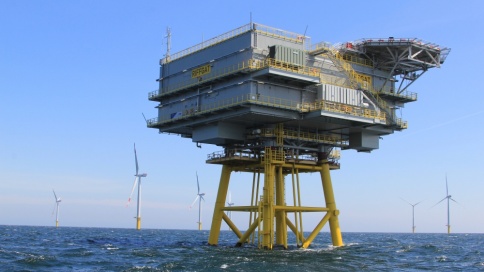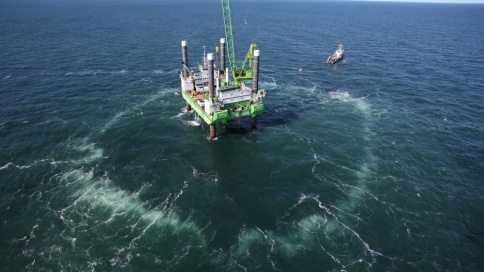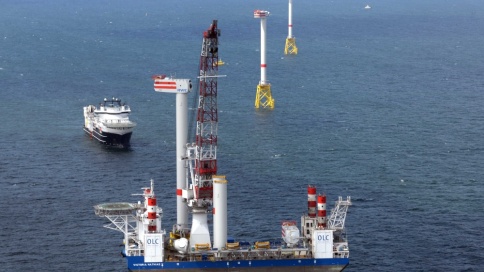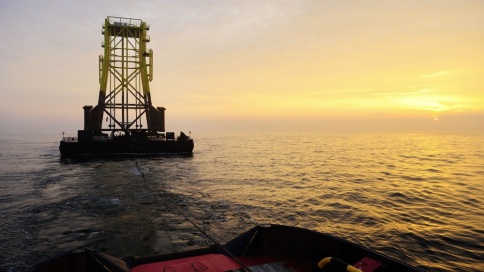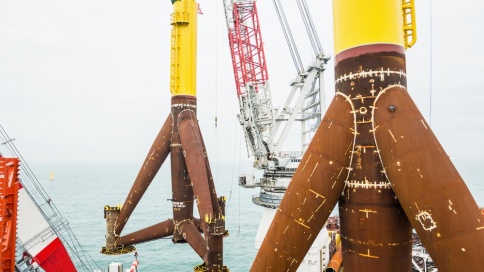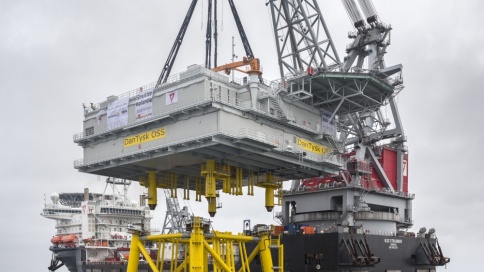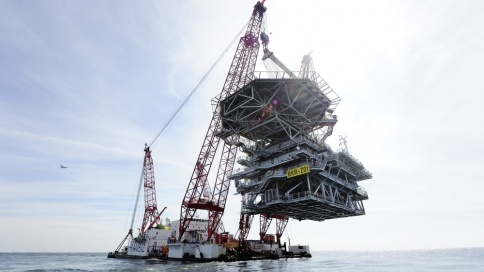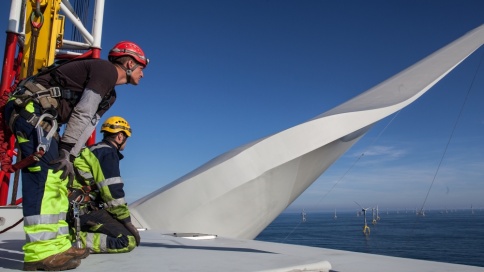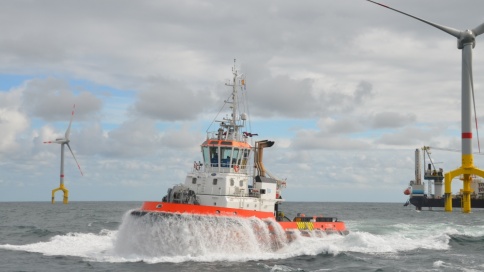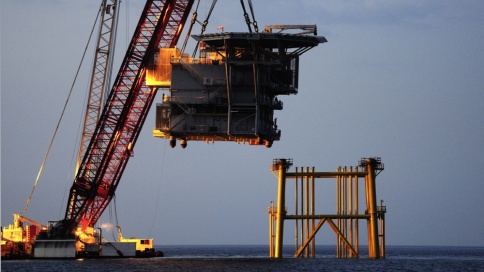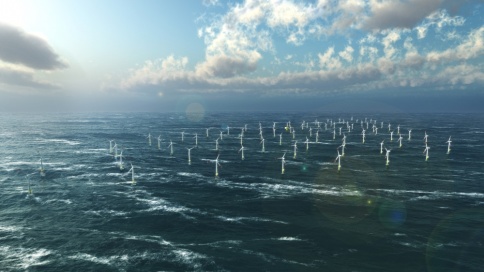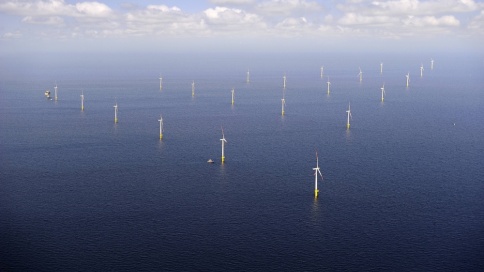Offshore Wind Energy – Clean Power from the Sea
The use of wind energy generated out at sea has ushered in a new era of environmentally friendly energy production. In 2018, offshore wind energy turbines produced roughly 18 Terrawatt-hours of clean electricity. By 2030, turbines off the coast of Germany will have a total capacity of 20 Gigawatts –enough to provide clean power to as many as 20 million households. This large-scale project is being supported by the German OFFSHORE WIND ENERGY Foundation, which was founded in 2005 at the initiative of the German offshore sector with support from the country's Environmental Ministry.
Offshore: great power generation off the coast
Offshore wind energy is all about using turbines to generate power out at sea. The biggest advantage is the constant, high wind speeds on the high seas, allowing offshore wind farms to produce twice as much power as comparable turbines on land. This aspect contributes to better power generation reliability. Offshore wind farms produce green power far more than 90 percent of the year, making them a form of renewable energy production that approaches baseload levels. Offshore wind energy therefore plays an important role in the energy transition (the large-scale move away from nuclear and fossil energy sources and toward renewable energy).
Super-sized wind energy
Offshore turbines are gigantic – the total weight of just one can easily exceed 1,000 tons, equivalent to about 1,000 VW Golf cars. The turbines themselves stand on foundations that can weigh up to 900 tons. The nacelle (where the technical equipment is housed) alone can weigh between 300 and 400 tons. Turbine dimensions are also super-sized. The five-megawatt turbines installed in the Alpha Ventus test field, for example, have a rotor diameter of up to 125 meters and a total height of more than 170 meters above the seafloor. Newer six-megawatt turbines can even reach a rotor diameter of around 150 meters – twice the wingspan of an Airbus A380.
Large-scale renewable projects on the high seas
Building a wind farm out at sea is a complex, large-scale project that requires a number of different players. The process from planning and approval to investment decisions and all the way to actual turbine installation can take at least five to ten years. The parties involved in creating an offshore wind farm include project developers, investors and/or future owners, governmental authorities, manufacturers and component suppliers, and maritime service providers, logistics specialists, and port operators.
Extreme conditions at sea
Storms, high waves, bad weather, and long distances from shore require special solutions in terms of both logistics and the technologies and materials used. Because of the extreme conditions at sea, the installation of an offshore wind farm progresses in stages. Anchoring the turbines into the seafloor is a particularly important stage of construction, since the turbines need to stand on secure foundations in order to withstand winds and bad weather for a long time. For this, solid foundation structures made out of, for example, steel tubes, are driven up to 30 meters into the seafloor. Because construction is so complex at sea, larger components are preassembled in the port and then brought to the site by special transport and installation vessels or jack-up platforms. These ships have a crane that helps attach the first tower segment or a transition piece to the foundation. Next, the turbine's tower segments, nacelle, and rotor blades are added one by one. Once an offshore turbine is up and running, it should experience as little downtime as possible; routine maintenance checks are therefore made on site to inspect the rotor blades, bearings, gears, and foundations. The turbines and their components are also remotely monitored from a control room on land.
For the simple reason of its location at sea, an offshore wind farm costs much more to plan, build, and operate than one on land. A 300 to 400-megawatt offshore wind farm requires investments of far more than one billion euros. However, the offshore sector is still very young, which means that learning curves, innovation, and new technology have a lot of potential for saving money, and costs for power from offshore wind will drop significantly in the next few years.
German law ensures stable compensation for offshore power
In order for renewable energy to expand quickly, offshore wind and other sources receive funding as stipulated in the German Renewable Energy Act (EEG). The law guarantees that grid operators will give precedence to green power in their purchases and provides for a fixed compensation rate over a defined period of time. These aspects give investors and operators greater planning security. There are, however, still risks, such as weather (wind yield) and reliability of the still relatively new turbine technology compared to wind energy on land.
The EEG stipulates compensation for offshore wind power of 15.4 cents per kilowatt-hour for the first twelve years (starting in August 2014). After that, the legally guaranteed rate drops to a quarter of the initial amount (3.9 cents per kilowatt-hour). Wind farm operators also have the option of choosing the "accelerated" model, in which the rate is 19.4 cents per kilowatt-hour initially but then drops to the lowest rate of 3.9 cents per kilowatt-hour after just eight years. Calculated over 20 years, the costs for offshore wind end up being in the middle of the pack relative to all renewable energy sources.
With the EEG 2017, fixed feed-in tariffs were phased out. Support payments are now determined via competitive auctions. At the first auction in 2017, developers bid for projects to be completed in 2021 to 2025. The next auction round starts on January 1, 2021 and will cover projects to be completed in 2026.
Environmental protection in the spotlight
The use of renewable energy, including offshore wind, is environmental protection in practice. The process of producing such power does not create any harmful carbon; the same cannot be said for fossil fuel sources such as coal, crude oil, and natural gas.
But environmental protection is in the spotlight even when offshore projects are in the construction phase. Considerable effort is made to protect the environment, develop sustainable materials, and design the production processes themselves to be as ecologically friendly as possible. Legal requirements for protecting the marine environment, especially the fauna, are already strict during the approval process for offshore wind farms. In Germany, for example, comprehensive noise control concepts must be presented for the construction phase, especially when the foundation structures are driven into the seafloor, in order to protect porpoises, which are sensitive to noise and protected by animal conservation laws, and other marine mammals.
Grid connection via 'multiple sockets'
Once the offshore wind turbine has been erected and is rotating, the built-in generator can produce electricity. But how does it get to the end user?
Each offshore wind farm has its own transformer platform to which all the turbines are connected in a bundle. Here the electricity is transformed to a higher voltage level for transmission on land. The power lines in the wind farm (internal farm cabling) are three-phase connections. For small and coastal projects, the electricity is fed directly to the next grid node on land via a submarine cable. However, wind farms with higher power and greater distance to the coast would incur very high transmission losses with three-phase technology. For this reason, the so-called cluster connection is used here, especially in the North Sea. This works like multiple sockets. The electricity is fed from the transformer stations of several offshore wind farms to another offshore platform - the so-called converter platform. There, the alternating current from the connected wind farms is converted into direct current and transmitted via a submarine cable to the next grid node on land, where it is in turn converted back into alternating current via an onshore converter. IThis is called high-voltage direct current transmission technology (HVDC). With this technology, significantly morepower can be dissipated per cable. The transmission losses are significantly lower than with three-phase current.
Offshore wind energy as a nationwide job engine
The expansion of offshore wind energy has great economic potential: total sales along the entire value chain amounted to around EUR 9 billion in 2018. From the development to the operation of an offshore wind farm, actors from different sectors are involved. The offshore wind industry in Germany currently employs around 24,500 people. A stronger expansion of offshore wind energy to 20 GW by 2030 could add around 8,000 jobs.
It is not only the ports and shipyards in the coastal regions that benefit from the economic potential of offshore wind energy. The former are home to the manufacturers of offshore wind turbines and their large components, as well as project developers and logistics companies. But also inland suppliers benefit, e.g. from the metal and mechanical engineering industries, technical service providers, insurance or financing companies, certifiers and consulting firms. Thus, the expansion of offshore wind energy offers growth impulses throughout Germany. The federal states with the highest turnover in terms of added value in the offshore wind energy sector are North Rhine-Westphalia, Baden-Württemberg, Bavaria, Lower Saxony and Hamburg.
